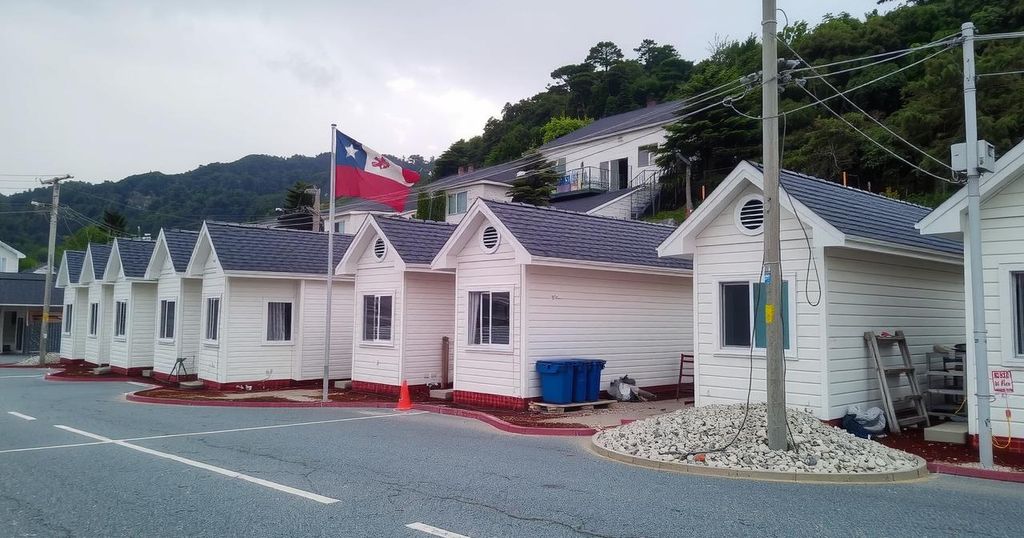One year after a devastating 7.5-magnitude earthquake struck Japan’s Noto Peninsula, residents like 83-year-old Sueko Naka face uncertainty living in temporary accommodations. With nearly 470 lives claimed and a significant decline in population, the community grapples with the slow recovery amid ongoing fears of aftershocks and additional disasters, while many families are scattered and lost.
In the aftermath of a catastrophic 7.5-magnitude earthquake that struck the Noto Peninsula in Ishikawa on January 1, 2024, many residents like 83-year-old Sueko Naka grapple with the harsh realities of temporary living conditions. Once hopeful to spend her remaining years at home, Ms. Naka now resides in a small temporary unit alongside her husband and daughter, dealing with the psychological trauma of having lost much in both the quake and its subsequent aftershocks. “When I imagine I might die here, I can’t sleep well,” Ms. Naka expressed, highlighting the uncertainty of their current situation.
The earthquake, Japan’s deadliest in over a decade, resulted in the deaths of nearly 470 individuals, with many perishing due to subsequent aftershocks and adverse weather. To date, approximately 40,000 people remain displaced, living in emergency shelters that have become a stark reminder of their disrupted lives. While some progress has been made in reconstruction, it is evident that recovery for the Ishikawa region is slow, with only a quarter of severely damaged structures demolished thus far. The persistent threat of aftershocks continues to instill fear among the population, further exacerbated by devastating floods in September that resulted in additional fatalities.
The structural damage caused by the earthquake has led to significant shifts in demographics, with the population of Wajima city declining by 2,500 individuals from the previous year, a concerning trend amidst Japan’s already existing depopulation crisis. Today, the haunting echoes of the calamity resonate deeply within the community as families like Ms. Naka’s grapple with the loss of their homes and loved ones, a painful reminder of their fragility in the face of nature’s wrath. Efforts to engage younger generations to remain in the area and contribute to the rebuilding process face formidable obstacles, particularly with critical infrastructure remaining compromised.
This tumultuous experience has scattered Ms. Naka’s family, compounding her sense of loss. Her daughter, Miyuki Kijima, has returned to support her aging parents but faces her own fears regarding future disasters. “We want to repair our home and live there again, but what if it happens again after we repair it?” she lamented. As the New Year approaches, what was traditionally a time of celebration has transformed into a period marked by anxiety and uncertainty for families in the region.
Thus, the Noto Peninsula exemplifies a poignant narrative of resilience amid adversity, while the ongoing recovery efforts serve as a testament to the courage and determination of those impacted.
Japan is no stranger to seismic activity due to its location along the Pacific Ring of Fire, leading to frequent earthquakes that profoundly affect its people and infrastructure. The January 1, 2024 earthquake was particularly devastating for the Noto Peninsula, an area that had experienced significant damage in the past. With rural settings and aging populations, challenges in rebuilding are magnified, compounded by subsequent natural disasters like severe flooding. The region has faced depopulation issues for years, further exacerbated by the loss of homes and livelihoods due to the earthquake.
The tragic events following the January 2024 earthquake on the Noto Peninsula highlight the complexities of recovery in a region already dealing with demographic challenges. As families like Ms. Naka’s navigate the emotional and physical repercussions of displacement and loss, the path forward remains fraught with difficulties. The struggle to rebuild amidst fears of future disasters emphasizes the importance of community resilience and support as the area seeks to restore stability.
Original Source: japantoday.com






